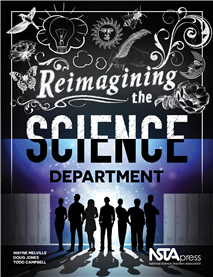All Book Chapters
Book Chapter
Phylogenetic Trees and the Classification of Fossils
The purpose of this lab is for students to apply what they have learned about phylogenetic trees and phylogenetic classification to determine ”How Should Biologists Classify the Seymouria?” The Teacher Notes provide the connections to standards, ...
Book Chapter
Descent With Modification and Embryonic Development
The purpose of this lab is for students to apply what they have learned about the theory of descent with modification to explain similarities in animal embryo development. The lab gives students an opportunity to use images of animal embryos to test ...
Book Chapter
In this chapter, the purpose of this Lab 18 is for students to apply what they know about migration, genetic drift, and natural selection to explain the evolution of beak size in a population of birds....
Book Chapter
The science department has existed in its current form for approximately 100 years. If, however, we believe that departments are places in which science teachers can begin to understand and challenge why they teach the way they do, and the imperative...
Book Chapter
Why Is Questioning a Powerful Teaching Tool?
Questioning cultivates student engagement and drives instruction throughout the learning process. It is a vital part of science and engineering. Questions challenge student thinking at key points within a lesson or unit of study to connect concepts a...
Book Chapter
How Do I Prepare for the Power of Questioning?
Involving students in the Powerful Practices model requires that you know your students as individuals and as a group. This will help create engaging questions and a collaborative environment that supports dynamic discussions, leading to purposeful l...
Book Chapter
How Do I Implement the Power of Questioning?
Sharing ideas with a partner or group helps students structure thoughts to communicate thinking and offers an opportunity for them to learn together. When you model metacognition and use a variety of questioning strategies, your students learn how to...
Book Chapter
Using the 5E Model to Implement the Next Generation Science Standards
This chapter provides recommendations for translating standards into instructional materials that are usable for those with the real task of teaching. The discussion provides an affirmative answer to the question: How can the BSCS 5E Instructional Mo...
Book Chapter
Why Does Skill in Questioning Engage Students in Purposeful Standards-Based Learning?
Students need to see purpose for what they are learning as they engage in literacy practices. Children ask questions and make connections to what is being learned in the classroom every day—on the playground, at home, walking to and from class, and...
Book Chapter
Teaching Science for Conceptual Understanding: An Overview
A primary goal of science education is teaching for conceptual understanding. But what does this mean? We argue that teaching for conceptual understanding can and should exist alongside the pressures of testing, “covering the curriculum,” and ins...
Book Chapter
Students With Disabilities and the Next Generation Science Standards
The Next Generation Science Standards require that students engage in science and engineering practices to develop deeper understanding of the disciplinary core ideas and crosscutting concepts. ...
Book Chapter
NGSS: Giving Every Student a Choice
The process for developing the Next Generation Science Standards (NGSS) was not a simple one. There were many decisions made that while necessary did not make the process simpler. However, one decision was never in debate—the NGSS were meant for al...
Book Chapter
This chapter serves two purposes. First, it provides a context for the work presented in A Framework for K–12 Science Education and the guiding document that underlies the Next Generation Science Standards (NGSS). Second, it discusses that scienc...
Book Chapter
On Building Policy Support for the <i>Next Generation Science Standards</i>
In this chapter, the editor discusses observations made as a foundation officer at Carnegie Corporation of New York throughout the development of the Common Core State Standards (CCSS) and the Next Generation Science Standards (NGSS). In particular,...
Book Chapter
Charges of the NGSS Diversity and Equity Team
This chapter summarizes the four tasks of the team. By understanding the far-reaching charges to address diversity and equity across many related topics and products, readers will appreciate how the interests of diverse student groups were taken into...






